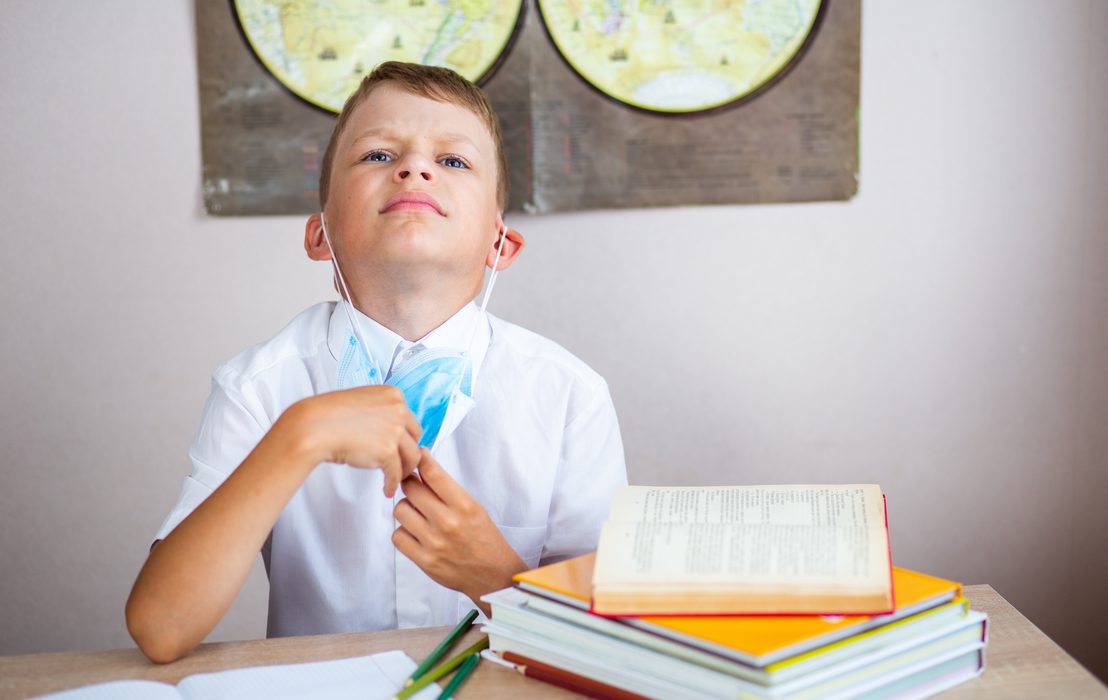Masks Off in the Classroom

If international travel is anything to go by, we will be stuck with silly public health restrictions for a long time. At Dulles International Airport, CDC notices remind you to “keep calm and wash your hands,” a message that is repeated ad nauseam over the intercom. Similar directives are everywhere at the Budapest and Frankfurt airports.
We’ve known that the risk of Covid-19 surface transmission is negligible for well over a year, but hand sanitizing stations dot concourses and airplane stewards still hand out complimentary wipes when you board your flight. Along with free pretzels and middling coffee, the smell of stale disinfectant has become a feature of flying.
For passengers, the cost of these interventions is minor, another inconvenience to add to the long list of indignities that plague modern air travel, from excessive baggage fees to intrusive security checks. What airports’ obsolete focus on surface cleaning reveals is how difficult it is for large organizations to adjust to their public health policies. Some of these guidelines, such as an insistence on masking students when schools reopen in the fall, will have far more serious consequences than tired airport employees dutifully reminding you to scrub your hands.
American public schools have been remarkably bad at managing the pandemic. Despite kids’ astonishing resistance to Covid-19, fearful parents, recalcitrant teacher unions, risk-averse bureaucrats, and a hysterical media climate combined to induce widespread school shutdowns. From cratering classroom achievement to a spike in teenage depression, the consequences of these closures have been widely felt.
Just as the costs of school closures were downplayed or ignored, mask mandates are sold as a minor inconvenience. This betrays a fundamental misunderstanding of how classroom instruction works. In language classes, non-verbal cues like facial expressions are vital for communicating with young learners. Something as simple as a smile can instantly clarify the meaning of an unfamiliar word or reassure an uncertain student. If you’ve ever tried speaking a second language with a masked interlocutor, whose words are muffled and facial expressions are obscured, you know that masks add an extra layer of difficulty to normal conversation.
Even with native speakers, facial expressions help make the classroom work. A withering glance can be more effective at enforcing discipline than a formal reprimand. A smile and a nod can encourage struggling students. Intonation, enunciation, and facial expressions, all of which greatly enrich our everyday conversations, are severely circumscribed or eliminated by masking. After a lost year of online schooling, we should be doing everything possible to return students to an ideal classroom environment.
The objection to kids taking off the masks is a predictable one: these mandates literally save lives. This lopsided calculus, which has justified a slew of misguided Covid policies from park closures to remote learning, is simply wrong. On the left and the right, clear-eyed observers have pointed out that kids are at very little risk from Covid-19. This is not some esoteric finding: the CDC’s own demographic data on pandemic mortality is publicly available.
Besides, any protection offered by school mask mandates is likely to be marginal. For reasons of comfort and availability, student masks are often made of cloth and not medical-grade material. They’re also constantly slipping off and being adjusted by fidgety kids. Ill-fitting homemade face coverings are not going to save a generation of schoolchildren from mass death, but they will make the classroom considerably less pleasant.
As for vulnerable parents and teachers, we have a solution that is both more effective and less disruptive than school mask mandates: vaccines. Vaccination dramatically reduces the risks of infection, hospitalization, and death from Covid-19. Instead of policing schoolchildren for mask wearing, we should redouble our efforts to win over skeptics and distribute doses to unvaccinated adults.
Throughout the pandemic, the CDC’s approach to the young has been comically skewed. Last May, the agency actually prescribed face coverings for all children over the age of 2 and double masking at outdoor summer camps. This is not the work of an organization that understands kids or the varying levels of risk posed by the pandemic. Instead, CDC guidance reflects the maximalist, better-safe-than-sorry approach of a public health establishment that is incapable of taking real-world factors into account. Teaching is difficult enough without covering everyone’s faces. When we go back to school in the fall, we should take the masks off and get back to normal.
Will Collins is a teacher in Budapest, Hungary.